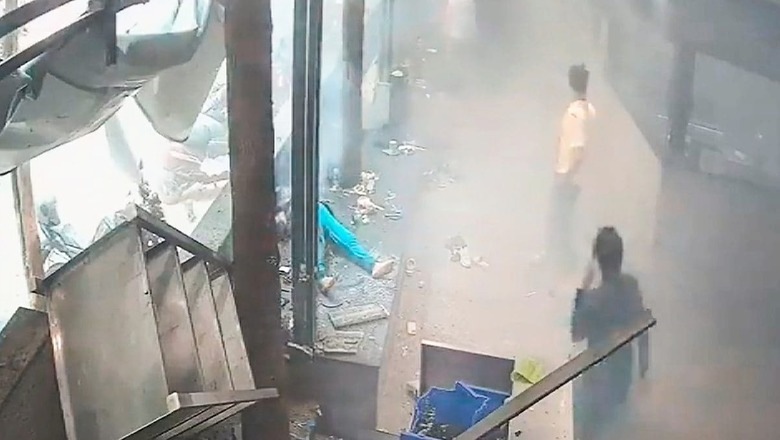
views
Bengaluru’s Rameshwaram Cafe blast probe has been taken over by the National Investigation Agency (NIA). Officials from the union ministry of home affairs confirmed to CNN-News18 that the case had been given to the NIA and a fresh FIR registered.
The central agency has unofficially collaborated with Bengaluru police from the start of the probe giving it a crucial understanding of the scene of the crime, the material evidence gathered, and leads about suspects, sources said.
At least nine people were injured in the blast around 1 pm on March 1 at the popular eatery in the city’s Whitefield area.
Shivamogga module
Sources told CNN-News18 that the Shivamogga module of Islamic State (ISIS or IS), which attempted an attack in Mangaluru in 2022, was being investigated. A pressure cooker packed with explosives had blown up in an autorickshaw in November 2022 and the subsequent investigation had unmasked the module. While Karnataka police and the NIA had arrested 10 people in connection with the blast, the suspected handlers are still at large.
Sources said the NIA is investigating if Abdul Matheen Taha and Musabir Hussain, believed to be the handlers of the Shivamogga module, had any role in last week’s Bengaluru blast at the quick-service eatery.
Officials said the jailed suspects of the Shivamogga case are being probed to see if they have any information about another ISIS module or the masked suspect captured on CCTV in Bengaluru. Mohammed Shariq, Maaz Muneer Ahmed, Syed Yasin, Reeshan Tajuddin Sheikh, Huzair Farhan Baig, Mazin Abdul Rahman, Nadeem Ahmed, Mohammed Zabilulla, Mohammed Faizal, and Arafath Ali — all in their 20s — have been named by the NIA in its charge sheet. While Shariq is a commerce graduate, Maaz Ahmed and Syed Yasin are engineers.
The anti-terror agency in its Shivamogga charge sheet had said that the main accused in the case recced multiple locations. “Both BTech graduates had been radicalised and motivated by an online foreign-based handler to target public and private properties, including warehouses, liquor outlets, hardware shops, vehicles, and properties belonging to citizens belonging to a particular community. In furtherance of conspiracy hatched by the Islamic State, Maaz and Yasin had committed over 25 incidents of arson and sabotage,” the NIA statement on the Shivamogga probe said.
A senior union home ministry official told CNN-News18 that the material evidence gathered from the Rameshwaram Cafe indicated that the improvised explosive device (IED) was assembled after looking at online videos, similar to the modus operandi in the Shivamogga case. “National Security Guards (NSG) picked up parts of the IED from the spot. Preliminary forensic analysis suggests a high-grade explosive packed tightly for maximum impact. The final forensic report is expected in 2-3 days but prima facie it looks like a bomb, which was assembled in a garage-like place, using online tutorial videos with material that you can order on e-commerce sites,” the officer said.
Hunt on for key suspect
The NIA is probing if the suspect seen dropping a bag at Rameshwaram Cafe is also part of an ISIS module. Officials indicated that the CCTV screengrab of the prime suspect, seen in multiple security camera clips, could be shown to the jailed ISIS module members for any possible leads about his identity.
The man wearing a cap, glasses, and mask, is seen dropping a plastic pouch taken out from a bag and placing it near the blast site minutes before the explosion around 1 pm on Friday. The same suspect is also captured on CCTV at the Kundalahalli bus stand, alighting from bus 500D. “The bus driver and conductor will be asked if they saw anyone resembling the suspect during the journey. Even if he was wearing a mask, a familiar person can be identified through his gait,” an investigating officer said.
CCTV footage from nearby areas of previous dates is also being scanned to check if the same person carried out a recce of the cafe earlier.
So far, no lead has emerged to conclude whether the suspect is a Bengaluru resident or came from outside.
Technical investigation
The mobile data dump of the towers around the blast site led investigators to question a few people who allegedly made suspicious calls. Now the NIA is also looking at the possibility that a crypto wallet may have been used for monetary transactions between the accused.
The agency in its Shivamogga probe found that hideouts for the suspects in Bengaluru were arranged using money from such crypto wallets. “These IS terror operatives were being paid in crypto currencies by their online handler by fund transfers from abroad. Investigations have revealed that Maaz received Crypto equivalent to around INR 1.5 lakhs from the online handler into accounts of his friends, whereas Syed Yasin received INR 62 K into the account of a friend,” an NIA statement in March 2023 revealed.


















Comments
0 comment